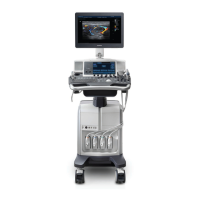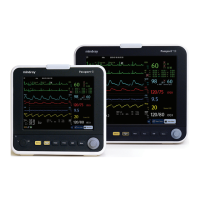5-7
5.3.3 ECG Tests
5.3.3.1 ECG Performance Test
Tool required:
Fluke Medsim 300B patient simulator or equivalent equipment
To perform an ECG performance test:
1. Connect the patient simulator with the ECG connector using an ECG cable.
2. Set the patient simulator as follows: ECG sinus rhythm, HR = 80 bpm with the amplitude as 1 mV.
3. Check the ECG waves are displayed correctly without noise and the displayed HR value is within 80 ± 1 bpm. If
the value is not within 80 +/-1 then contact Mindray Technical Support.
4. Disconnect each of the leads in turn and observe the corresponding lead off message displayed on the screen.
5. Set the simulator outputs paced signals and set [Paced] to [Yes] on the monitor. Check the pace pulse marks on
the monitor screen.
5.3.3.2 ECG Verification
Tool required:
Vernier caliper
To perform an ECG verification:
1. Select the ECG parameter window or waveform area and set [Filter] to [Diagnostic].
2. Select [Main Menu]
→
[Maintenance >>]→ [User Maintenance >>]→ enter the required password→
[Module Maintenance>>].
3. Select [Calibrate ECG]. A square wave appears on the screen and the message [ECG calibrating] is displayed.
4. Compare the amplitude of the square wave with the wave scale. The difference should be within 5%. If the
difference is not within 5% contact Mindray Technical Support.
After completing the calibration, select [Stop Calibrating ECG].
5.3.4 Resp Performance Test
Tool required:
Fluke Medsim 300B patient simulator or equivalent equipment
To perform a Resp performance test:
1. Connect the patient simulator to the module using a non ESU-proof cable and set lead II as the respiration lead.
2. Configure the simulator as follows: lead II as the respiration lead, base impedance line as 1500 Ω, data impedance
as 0.5 Ω, and respiration rate as 40 rpm.
3. Verify the Resp wave is displayed without any distortion and the displayed Resp value is within 40 ± 2 rpm.
